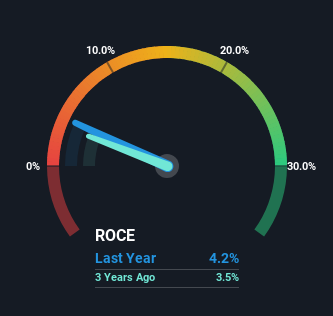- Hong Kong
- /
- Healthcare Services
- /
- SEHK:2120
Wenzhou Kangning Hospital (HKG:2120) Could Be Struggling To Allocate Capital

To find a multi-bagger stock, what are the underlying trends we should look for in a business? Firstly, we'll want to see a proven return on capital employed (ROCE) that is increasing, and secondly, an expanding base of capital employed. This shows us that it's a compounding machine, able to continually reinvest its earnings back into the business and generate higher returns. In light of that, when we looked at Wenzhou Kangning Hospital (HKG:2120) and its ROCE trend, we weren't exactly thrilled.
What Is Return On Capital Employed (ROCE)?
For those that aren't sure what ROCE is, it measures the amount of pre-tax profits a company can generate from the capital employed in its business. The formula for this calculation on Wenzhou Kangning Hospital is:
Return on Capital Employed = Earnings Before Interest and Tax (EBIT) ÷ (Total Assets - Current Liabilities)
0.042 = CN¥83m ÷ (CN¥2.6b - CN¥657m) (Based on the trailing twelve months to December 2022).
Thus, Wenzhou Kangning Hospital has an ROCE of 4.2%. In absolute terms, that's a low return and it also under-performs the Healthcare industry average of 12%.
Check out our latest analysis for Wenzhou Kangning Hospital

Historical performance is a great place to start when researching a stock so above you can see the gauge for Wenzhou Kangning Hospital's ROCE against it's prior returns. If you're interested in investigating Wenzhou Kangning Hospital's past further, check out this free graph of past earnings, revenue and cash flow.
How Are Returns Trending?
When we looked at the ROCE trend at Wenzhou Kangning Hospital, we didn't gain much confidence. To be more specific, ROCE has fallen from 8.1% over the last five years. Although, given both revenue and the amount of assets employed in the business have increased, it could suggest the company is investing in growth, and the extra capital has led to a short-term reduction in ROCE. And if the increased capital generates additional returns, the business, and thus shareholders, will benefit in the long run.
Our Take On Wenzhou Kangning Hospital's ROCE
While returns have fallen for Wenzhou Kangning Hospital in recent times, we're encouraged to see that sales are growing and that the business is reinvesting in its operations. And there could be an opportunity here if other metrics look good too, because the stock has declined 69% in the last five years. So we think it'd be worthwhile to look further into this stock given the trends look encouraging.
Wenzhou Kangning Hospital does have some risks, we noticed 3 warning signs (and 2 which are a bit concerning) we think you should know about.
While Wenzhou Kangning Hospital isn't earning the highest return, check out this free list of companies that are earning high returns on equity with solid balance sheets.
If you're looking to trade Wenzhou Kangning Hospital, open an account with the lowest-cost platform trusted by professionals, Interactive Brokers.
With clients in over 200 countries and territories, and access to 160 markets, IBKR lets you trade stocks, options, futures, forex, bonds and funds from a single integrated account.
Enjoy no hidden fees, no account minimums, and FX conversion rates as low as 0.03%, far better than what most brokers offer.
Sponsored ContentValuation is complex, but we're here to simplify it.
Discover if Wenzhou Kangning Hospital might be undervalued or overvalued with our detailed analysis, featuring fair value estimates, potential risks, dividends, insider trades, and its financial condition.
Access Free AnalysisHave feedback on this article? Concerned about the content? Get in touch with us directly. Alternatively, email editorial-team (at) simplywallst.com.
This article by Simply Wall St is general in nature. We provide commentary based on historical data and analyst forecasts only using an unbiased methodology and our articles are not intended to be financial advice. It does not constitute a recommendation to buy or sell any stock, and does not take account of your objectives, or your financial situation. We aim to bring you long-term focused analysis driven by fundamental data. Note that our analysis may not factor in the latest price-sensitive company announcements or qualitative material. Simply Wall St has no position in any stocks mentioned.
About SEHK:2120
Wenzhou Kangning Hospital
Operates a network of healthcare facilities in the People’s Republic of China.
Slight with mediocre balance sheet.
Market Insights
Community Narratives



